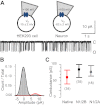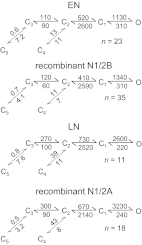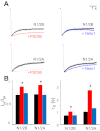Gating reaction mechanism of neuronal NMDA receptors
- PMID: 22993263
- PMCID: PMC3544869
- DOI: 10.1152/jn.00551.2012
Gating reaction mechanism of neuronal NMDA receptors
Abstract
The activation mechanisms of recombinant N-methyl-d-aspartate receptors (NRs) have been established in sufficient detail to account for their single channel and macroscopic responses; however, the reaction mechanism of native NRs remains uncertain due to indetermination of the isoforms expressed and possible neuron-specific factors. To delineate the activation mechanism of native NRs, we examined the kinetic properties of currents generated by individual channels located at the soma of cultured rat neurons. Cells were dissociated from the embryonic cerebral cortex or hippocampus, and on-cell single channel recordings were done between 4 and 50 days in vitro (DIV). We observed two types of kinetics that correlated with the age of the culture. When we segregated recordings by culture age, we found that receptors recorded from early (4-33 DIV) and late (25-50 DIV) cultures had smaller unitary conductances but had kinetic profiles that matched closely those of recombinant 2B- or 2A-containing receptors, respectively. In addition, we examined the effects of cotransfection with postsynaptic density protein 95 or neuropilin tolloid-like protein 1 on recombinant receptors expressed in human embryonic kidney-293 cells. Our results add support to the view that neuronal cultures recapitulate the developmental patterns of receptor expression observed in the intact animal and demonstrate that the activation mechanism of somatic neuronal NRs is similar to that described for recombinant receptors of defined subunit composition.
Figures







Similar articles
-
Developmental decrease in NMDA receptor desensitization associated with shift to synapse and interaction with postsynaptic density-95.J Neurosci. 2003 Dec 3;23(35):11244-54. doi: 10.1523/JNEUROSCI.23-35-11244.2003. J Neurosci. 2003. PMID: 14657184 Free PMC article.
-
Regulation of dopamine D1 receptor dynamics within the postsynaptic density of hippocampal glutamate synapses.PLoS One. 2013 Sep 6;8(9):e74512. doi: 10.1371/journal.pone.0074512. eCollection 2013. PLoS One. 2013. PMID: 24040266 Free PMC article.
-
Nickel modulates the electrical activity of cultured cortical neurons through a specific effect on N-methyl-D-aspartate receptor channels.Neuroscience. 2011 Mar 17;177:43-55. doi: 10.1016/j.neuroscience.2010.12.018. Epub 2010 Dec 21. Neuroscience. 2011. PMID: 21182900
-
C-terminal domains of N-methyl-D-aspartic acid receptor modulate unitary channel conductance and gating.J Biol Chem. 2012 Oct 19;287(43):36071-80. doi: 10.1074/jbc.M112.390013. Epub 2012 Sep 4. J Biol Chem. 2012. PMID: 22948148 Free PMC article.
-
Developmental and cell-selective variations in N-methyl-D-aspartate receptor degradation by calpain.J Neurochem. 2006 Oct;99(1):206-17. doi: 10.1111/j.1471-4159.2006.04096.x. Epub 2006 Aug 8. J Neurochem. 2006. PMID: 16899064 Free PMC article.
Cited by
-
Cross-subunit interactions that stabilize open states mediate gating in NMDA receptors.Proc Natl Acad Sci U S A. 2021 Jan 12;118(2):e2007511118. doi: 10.1073/pnas.2007511118. Proc Natl Acad Sci U S A. 2021. PMID: 33384330 Free PMC article.
-
Membrane Stretch Gates NMDA Receptors.J Neurosci. 2022 Jul 20;42(29):5672-5680. doi: 10.1523/JNEUROSCI.0350-22.2022. Epub 2022 Jun 15. J Neurosci. 2022. PMID: 35705487 Free PMC article.
-
Stargazin Modulation of AMPA Receptors.Cell Rep. 2016 Oct 4;17(2):328-335. doi: 10.1016/j.celrep.2016.09.014. Cell Rep. 2016. PMID: 27705782 Free PMC article.
-
Separate intramolecular targets for protein kinase A control N-methyl-D-aspartate receptor gating and Ca2+ permeability.J Biol Chem. 2014 Jul 4;289(27):18805-17. doi: 10.1074/jbc.M113.537282. Epub 2014 May 20. J Biol Chem. 2014. PMID: 24847051 Free PMC article.
-
Estimating the Ca2+ Permeability of NMDA Receptors with Whole-Cell Patch-Clamp Electrophysiology.Methods Mol Biol. 2024;2799:177-200. doi: 10.1007/978-1-0716-3830-9_10. Methods Mol Biol. 2024. PMID: 38727908 Free PMC article.
References
-
- Banke TG, Traynelis SF. Activation of NR1/NR2B NMDA receptors. Nat Neurosci 6: 144–152, 2003 - PubMed
Publication types
MeSH terms
Substances
Grants and funding
LinkOut - more resources
Full Text Sources
Research Materials

